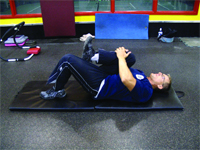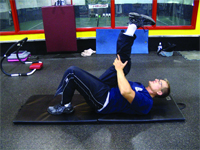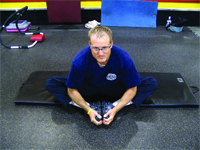
Features
Health and wellness
Hot topics
Fit For Life: Preventing back injuries
The two most common types of injuries that happen around a fire hall are slip-and-fall injuries and improper lifting injuries. The fourth edition of The Essentials of Fire Fighting says, “Back injuries have been statistically proven to be the most expensive single type of accident in terms of worker’s compensation, and they occur with surprising frequency.” Back injuries can be frustrating as sufferers are restricted in their mobility during rehab and full recovery can take a long time.
January 21, 2008
By Aaron Brouwer
 The two most common types of injuries that happen around a fire hall are slip-and-fall injuries and improper lifting injuries. The fourth edition of The Essentials of Fire Fighting says, “Back injuries have been statistically proven to be the most expensive single type of accident in terms of worker’s compensation, and they occur with surprising frequency.” Back injuries can be frustrating as sufferers are restricted in their mobility during rehab and full recovery can take a long time. It is important that you take care of your back by being proactive in prevention.
The two most common types of injuries that happen around a fire hall are slip-and-fall injuries and improper lifting injuries. The fourth edition of The Essentials of Fire Fighting says, “Back injuries have been statistically proven to be the most expensive single type of accident in terms of worker’s compensation, and they occur with surprising frequency.” Back injuries can be frustrating as sufferers are restricted in their mobility during rehab and full recovery can take a long time. It is important that you take care of your back by being proactive in prevention.
Improper lifting techniques not only put unnecessary strain on muscle but can also lead to damage of expensive equipment.
Here are some rules to live by when lifting:
• Always get extra help when an object is too heavy.
• Do not attempt to lift heavy or awkward items by yourself.
• Plan the lift ahead of time. Knowing who is going where and how you are going to lift will make the carry that much easier and safer. When counting to three for the lift, knowing whether you are lifting on three or after three will prevent potential injury.
• If you feel the object starting to slip, stop and put it down to readjust your grip. Do not try to be a hero and carry it all the way. If the object drops you risk damaging it, injuries to feet and possibly hurting the others carrying the object as they fall over.
• There is never just one way to lift an object. Use the safest method. This could mean stopping and changing positions depending on the terrain, for example, your technique will be different on flat floors than on stairs.
Most back injuries are not the result of a single event; they are the result of regular improper lifting over time. By consistently putting unnecessary strain on your back you are slowly building up to a major injury. Every time you lift an object, use proper lifting techniques no matter how heavy or light the item may be. The buildup of previous improper lifting may finally set off a major injury when you pick up a small item.
Things to remember when you are required to carry heavy objects:
• Keep the item close to your body – this will put less stress on your back and shoulder muscles;
• When you need to change directions, move your feet first then your back (don’t twist your back to make a direction change);
• Use your knees when lifting;
• Keep your back straight.
If you suffer from acute low back pain, here are some things you can do on your own to go alongside of what your doctor recommends.
Find a comfortable position: www.backpainreliefonline.com recommends the 90-90 position. To get into the 90-90 position, lie on your back with your legs on top of a footstool, chair or other surface so that your hips and knees are bent at 90 degrees (right angles). This position will relieve some of the pressure put on your back.
Ice will help reduce inflammation around the area by slowing down the pain nerve’s transmission signals. The website www.webmd.com defines inflammation as the process by which the body's white blood cells and chemicals protect our bodies from infection by foreign
substances, such as bacteria and viruses. If inflammation runs unchecked it can lead to a host of diseases, such as atherosclerosis and rheumatoid arthritis. Ice your injury for 15 to 20 minutes but never longer than that and then allow at least an hour before icing again. Lisa James compares inflammation to a campfire in her article The Hidden Fire found at www.nutricentre.com. “Inflammation that continues unchecked can, like a campfire-turned-wildfire, wreak widespread havoc on your health.” Remember to ice regularly during the first few days of your injury.
Here are four stretches you can do to help prevent back injuries:
Knee to chest – bent knee (stretches gluteus, lower back, hamstrings, and quadriceps)
• Lay flat on back with knees bent.
• Grab under right thigh and pull knee toward chest until you feel mild tension.
• Hold for 10 seconds, and then pull slightly farther until you feel slightly more tension.
• Hold this position for 10 seconds.
• Repeat with other leg.
Knee to chest – leg straight (stretches gluteus, lower back, hamstrings, and quadriceps)
• Lay flat on back with knees bent.
• Grab under right thigh and straighten right leg. Do not lock knee.
• Hold for 10 seconds, and then pull slightly farther until you feel slightly more tension.
• Hold this position for 10 seconds.
• Repeat with other leg.
Butterfly stretch (stretches groin and lower back)
• Sit upright with the bottoms of your feet touching each other.
• Bend forward at the waist to a position where you feel mild tension.
• Elbows can be used to push down on thighs if you want more stretch.
• Hold for 10 seconds, and then pull slightly farther until you feel slightly more tension.
• Hold this position for 10 seconds.
Upper back stretch (stretches upper back and posterior deltoids)
• Sit with legs straight in front.
• Twist your upper back crossing left arm across chest and place your right hand on the floor.
• Slowly twist until you feel mild
tension.
• Hold for 10 seconds, and then pull slightly farther until you feel slightly more tension.
• Hold this position for 10 seconds.
• Return to starting position and twist to the other side.
The Home Depot back injury prevention program says “back-injury prevention is a lifestyle, not a one-time event.” Firefighters need to adopt this kind of mentality. There are several ways to prevent back injuries: working your core (abs, back and thighs) muscles; stretching; and using proper lifting techniques. Remember that most back injuries are not the result of a single event, so make back-injury prevention your lifestyle at work and at home.
 |
| PHOTOS COURTESY DARRIN MEIER Knee to chest – bent knee |
 |
| Knee to chest – leg straight |
 |
| Butterfly stretch |
Aaron Brouwer has 17 years of combined experience in structural and wildland fires. A graduate of Trinity Western University with a Bachelor’s of Human Kinetics, he is an instructor with Canwest Fire. E-mail him at ffbrouwer@hotmail.com.
Print this page